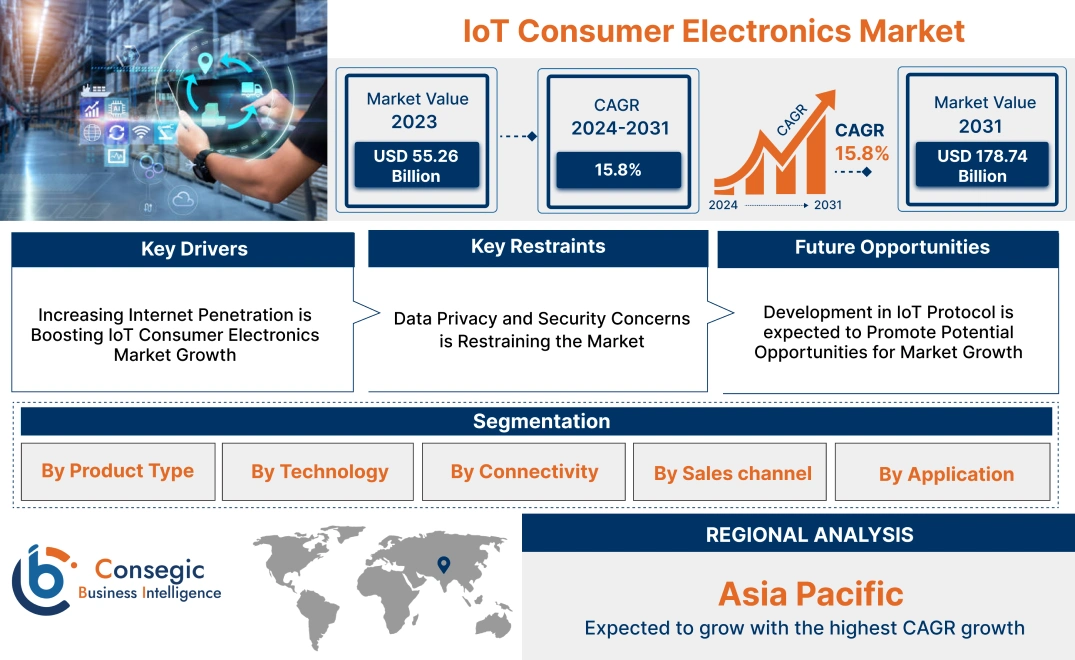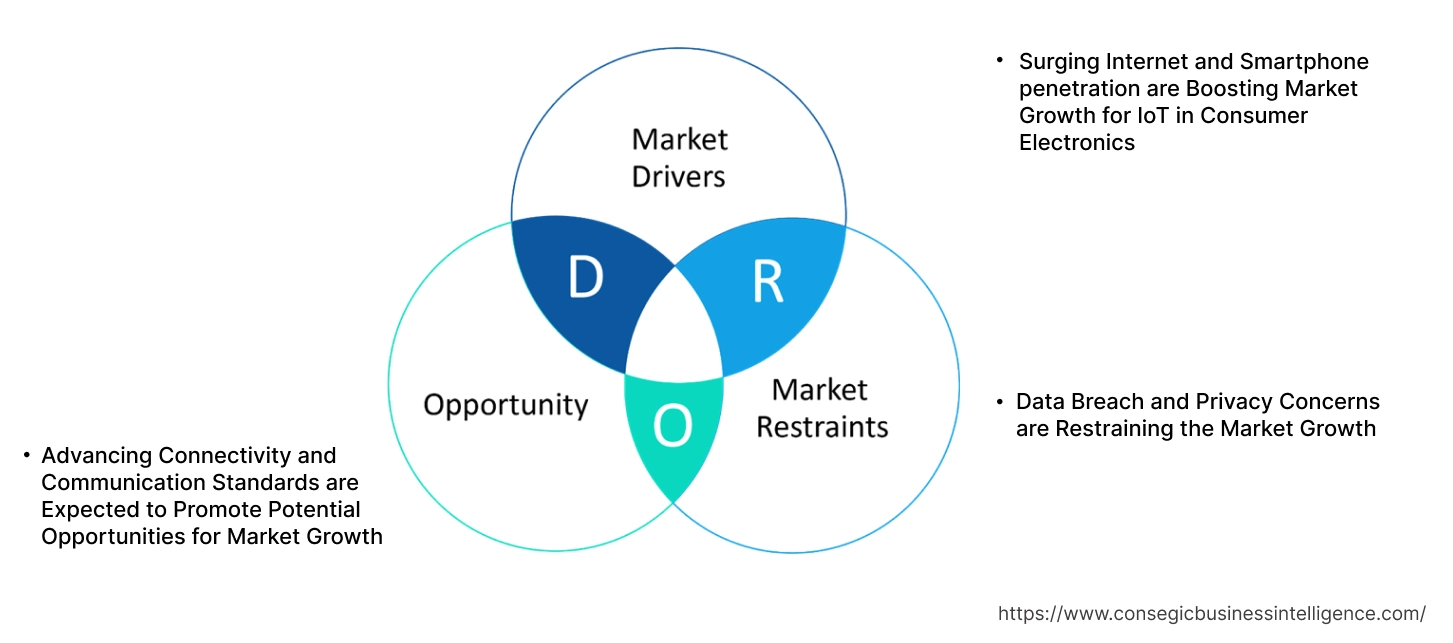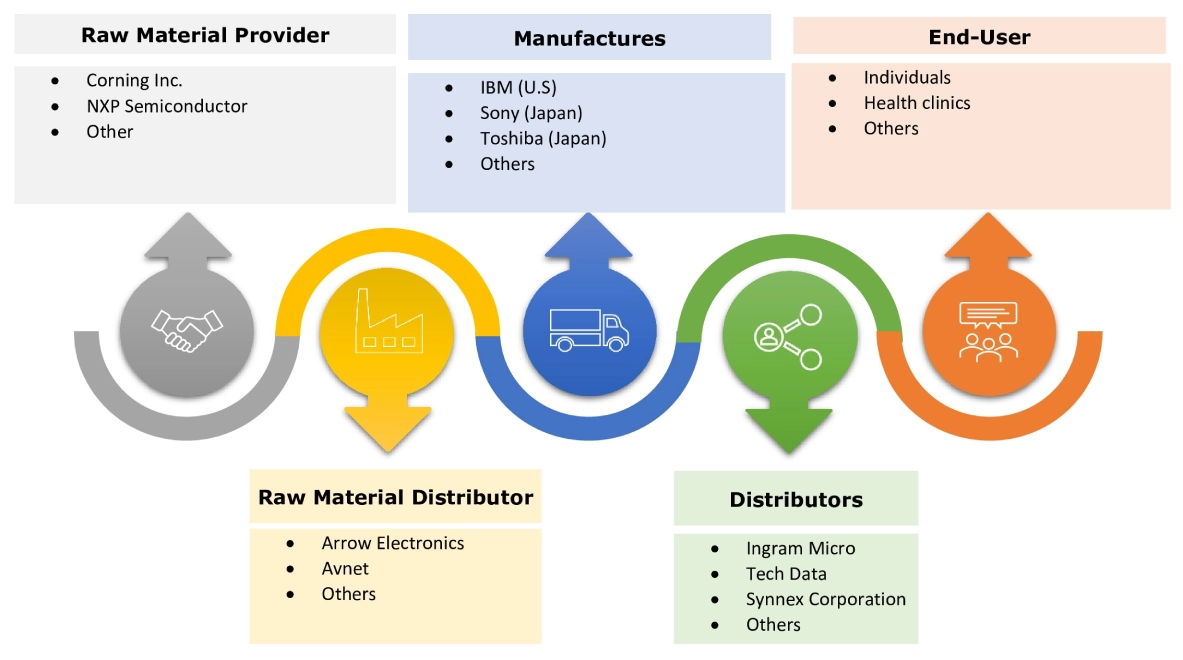IoT in Consumer Electronics Market Size:
IoT in Consumer Electronics Market size is estimated to reach over USD 286.77 Billion by 2032 from a value of USD 64.07 Billion in 2024 and is projected to grow by USD 76.16 Billion in 2025, growing at a CAGR of 15.87% from 2025 to 2032
IoT in Consumer Electronics Market Scope & Overview:
IoT in consumer electronics refers to integrating internet connectivity, IoT sensors, and smart software to devices such as smartphones, wearables, smart home appliances, and TVs, among others. These devices are the used to collect and share data to provide enhanced convenience, personalized experiences, and efficiency for users. Additionally, the integration enables remote control, predictive maintenance, and real-time insights, and enables seamless communication is driving the IoT in consumer electronics market demand. Moreover, key benefits including automation, enhanced security and safety, increased energy efficiency, cost reduction, asset tracking, and management, among others are boosting the IoT in consumer electronics market growth. Further, the expansion of the Internet of Things (IoT) creates interconnected ecosystems, which in turn fuel the IoT in consumer electronics industry.
How is AI Impacting the IoT in the Consumer Electronics Market?
AI enhances the market by processing large volumes of data for providing personalized experiences, predictive maintenance, and automation, in turn making devices more efficient and helpful. Also, AI analyzes user behavior and preferences to customize device settings, such as adjusting smart home lighting and recommending content on connected TVs. Further, artificial intelligence, through natural language processing (NLP), enables seamless voice commands for hands-free operation of various devices like smart speakers and assistants. Furthermore, AI-powered IoT devices automate tasks by learning habits and automatically adjusting temperature, lighting, and security systems for increased comfort and efficiency.
IoT in Consumer Electronics Market Dynamics - (DRO) :
Key Drivers:
Surging Internet and Smartphone penetration are Boosting Market Growth for IoT in Consumer Electronics
Surging internet and smartphone penetration enables greater connectivity for smart devices and fosters a growing demand for convenience and enhanced lifestyles. Additionally, the affordable internet plans and advanced 4G/5G networks are paving the way for the increasing adoption of smart devices such as smart TVs and wearables, boosting the IoT in consumer electronics market growth. Additionally, consumers are increasingly focusing on convenience and improving lifestyles, leading to a surge in the need for smart home devices which in turn is driving the IoT in consumer electronics market demand.
- For instance, in May 2025, according to PIB India, 82.1% of rural households have at least one smartphone, as well as 91.3% in urban areas. Additionally, 83.3% of rural householdshave access to internet facilities within household premises, as well as 91.6% in urban areas.
Therefore, the rising internet and smartphone penetration are driving the adoption of IoT connected devices, in turn, proliferating the growth of the market.
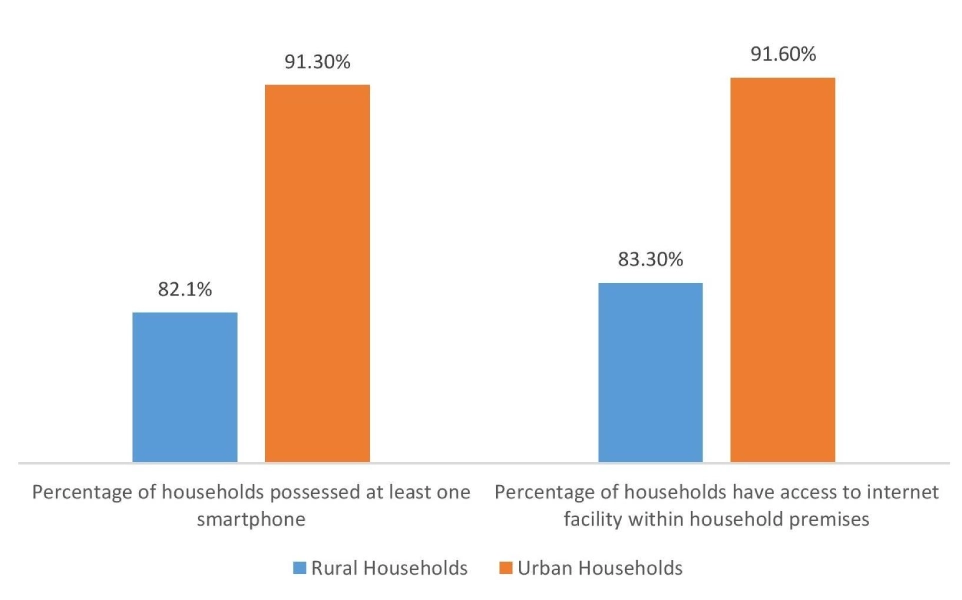
Key Restraints :
Data Breach and Privacy Concerns are Restraining the Market Growth
IoT devices collect vast amounts of personal data and often lack robust security measures, leading to risks of data breaches and unauthorized access, which hinders the IoT in consumer electronics market expansion. Additionally, weak default security settings, insufficient encryption, lack of firmware updates, and others allow attackers to intercept data, spy on users, and take control of devices, which hampers the safety and security of family members.
Therefore, the privacy concerns and data breaches are hampering the IoT in consumer electronics market expansion.
Future Opportunities :
Advancing Connectivity and Communication Standards are Expected to Promote Potential Opportunities for Market Growth
Advancing connectivity standards like 5G and emerging protocols such as Matter are enabling more seamless, reliable, and interconnected device ecosystems which in turn are paving the way for IoT in consumer electronics market opportunities. Additionally, the key features include low-latency, real-time data exchange, and easy device compatibility are creating significant progress prospects for the market. Furthermore, the ongoing rollout of 5G networks provides the necessary high-speed, low-latency, and energy-efficient connectivity to support a vast array of IoT devices.
- For instance, in July 2025, Soracom launched a connectivity hypervisor that is designed to provide flexibility and control over IoT deployments. The platform features dynamic remote management and switching of multiple connectivity profiles on a single eSIM.
Hence, the advancing connectivity and communication standards are anticipated to increase the utilization of IoT devices, in turn promoting prospects for IoT in consumer electronics market opportunities during the forecast period.
IoT in Consumer Electronics Market Segmental Analysis :
By Product Type:
Based on the product type, the market is segmented into smartphones, printers, wearable devices, smart TV, kitchen appliances, and others.
Trends in the Product Type:
- The IoT integration into wearable devices fosters personalized insights into health and daily life, enabling chronic disease management, remote diagnostics, and personalized health feedback is driving the IoT in consumer electronics market trends.
- Smart TVs are increasingly integrating AI and machine learning for enhanced user experience by providing automatic user assistance and enhance overall user experience is driving the IoT in consumer electronics market trends.
The smartphones accounted for the largest revenue share of 33.12% in the year 2024 and are anticipated to register the fastest CAGR during the forecast period.
- Smartphones provide a user-friendly interface to control and interact with various connected devices, as well as serve as a central point for managing smart home devices, wearables, and other connected electronics through mobile apps, giving users better insights into their environment and habits.
- Additionally, the key advantages that boost the IoT in consumer electronics market share include increased convenience and comfort, cost savings, enhanced safety and health, among others.
- Further, the growing demand for convenience, automation, and enhanced lifestyles is boosting the adoption of smartphones, which in turn is fueling the IoT in consumer electronics market share.
- Furthermore, the availability of high-speed internet, due to the rise of 4G and 5G networks, is paving the way for growing IoT in consumer electronics market size.
- For instance, in 2023, according to the International Telecommunication Union (ITU), 97.3% of the population in North America are using the internet facility, followed by Europe and Central Asia with 90.1% across the globe.
- Thus, as per the IoT in consumer electronics marketanalysis, the widespread availability of high-speed internet, as well as growing demand for convenience, automation, and enhanced lifestyles, is driving the market progress.
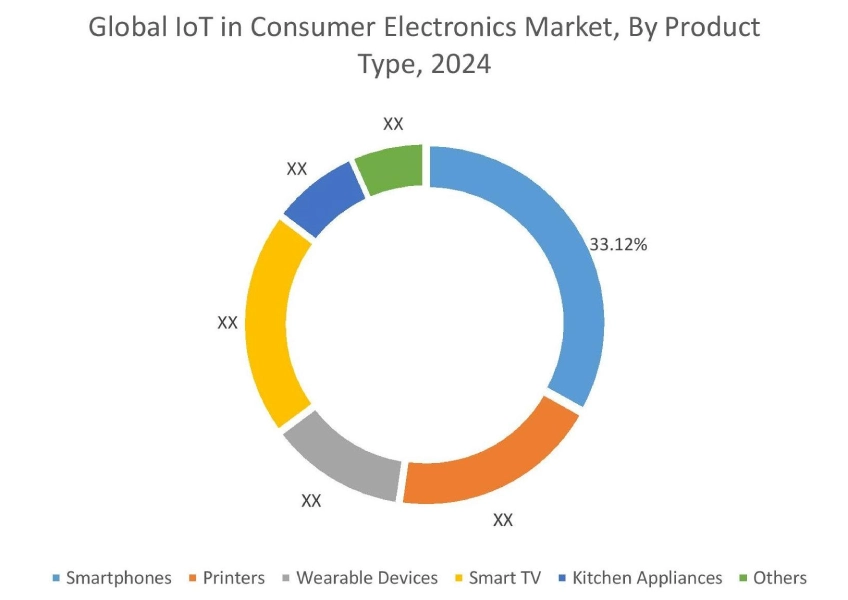
By Technology:
Based on the technology, the market is segmented into near field communication (NFC), LoRaWAN, RFID, artificial intelligence (AI), and Others.
Trends in the Technology:
- The trend towards the rise of personalized retail experiences and efficient supply chains for consumer electronics is driving the integration of IoT devices with RFID technology.
- The trend towards the integration of LoRaWAN's long-range, low-power capabilities with the high-speed, high-capacity 5G network, aids in enhancing IoT deployments.
Near Field Communication (NFC) Technology accounted for the largest revenue share in the year 2024.
- Near Field Communication is a short-range wireless technology that connects Internet of Things (IoT) devices in consumer electronics to facilitate easy, secure data exchange through simple taps or proximity.
- Additionally, the key advantages driving the adoption of NFC technology include ease of use, enhanced security, operational efficiency, reduced power consumption and others.
- Further, the growing demand for smart homes, smart cities, and connected health devices is driving the integration of NFC with IoT connected devices which in turn is fueling the IoT in consumer electronics market size.
- For instance, In March 2023, Infineon Technologies AG launched NGC1081, which is an NFC-based sensing controller that enables the IoT industry to develop low-cost, miniaturized devices and can be controlled and powered by mobile phones.
- Thus, as per the IoT in consumer electronics market analysis, the growing demand for smart homes, smart cities, and connected health devices is driving the market progress.
Artificial Intelligence (AI) is anticipated to register the fastest CAGR during the forecast period.
- AI algorithms enable IoT devices to learn user preferences and automate tasks without human intervention, such as adjusting home lighting and temperature among others based on patterns of use.
- Also, AI have the ability to offer predictive insights and recommendations, which helps to provide customized experiences in devices such as smartwatches and home entertainment systems.
- Further, the reduced cost of components such as sensors and microcontrollers is paving the way for IoT hardware to be accessible is driving the way for AI integration with IoT connected devices.
- For instance, In August 2024, Wiliot launched WiliBot which is a Gen AI chatbot which enables natural-language conversations with IoT-connected products.
- Therefore, as per the market analysis, the aforementioned factors are anticipated to boost the market during the forecast period.
By Connectivity:
Based on the connectivity, the market is bifurcated into wired and wireless.
Trends in the Connectivity:
- The trend towards increasing dominance of smartphones as central control hubs is driving the adoption of wireless connectivity.
- The wired connections offer a stable and less-interfering connection, making them a reliable choice for smart home infrastructure which is driving the market progress.
Wireless connectivity accounted for the largest revenue share in the year 2024 and is anticipated to register the fastest CAGR during the forecast period.
- The rise of wireless connectivity technology, such as Wi-Fi, Bluetooth, cellular, and other technologies, is providing easy, short-range wireless access to connect smart devices such as TVs, refrigerators, and security cameras, among others.
- Also, the key advantages include increased convenience, home automation, enhanced security, and better health monitoring, among others are boosting the adoption of wireless connectivity in the market.
- Further, Wireless connectivity is crucial, as it allows IoT devices to send and receive data for remote monitoring, control, and automation.
- Furthermore, the advancements in wireless technologies, as well as rising disposable incomes, are fueling the market development.
- Thus, as per the marketanalysis, the advancements in wireless technologies are driving the market progress.
By Sales Channel:
Based on the sales channel, the market is bifurcated into offline and online.
Trends in the Sales channel:
- The development of e-commerce, particularly DTC models, which bypass intermediaries, as well as offers a more personalized experience is driving the adoption of online sales channels.
- The increasing disposable incomes in developing economies is boosting the adoption of online sales channels.
Offline sales channel accounted for the largest revenue share in the year 2024.
- The offline sales channels provide a dominant revenue share due to the tangible product experience and personalized services offered at the offline stores.
- Also, the strategies adopted by offline stores to attract customers include in-store demonstrations, brand presence, and immediate assistance for complex IoT devices.
- Additionally, In-store associates can provide personalized advice and assistance with product specifications and usage which is a significant advantage driving the adoption of offline sales channel.
- Further, the retail stores can establish a stronger brand presence and build customer trust, leading to greater loyalty is boosting the market development.
- Thus, as per the market analysis, the aforementioned key factors are driving the adoption of offline sales channel is boosting the market progress.
Online sales channel is anticipated to register the fastest CAGR during the forecast period.
- The online sales channel aids manufacturers and retailers to leverage data analytics for dynamic pricing, personalized marketing, and improved customer engagement.
- Further, the online platforms such as e-commerce sites and company websites allow for broader distribution and access to a global customer base is driving the market progress.
- Furthermore, the rising integration of AI and virtual reality (VR) in online channels to provide personalized product recommendations and interactive shopping experiences is fueling the market evolution.
- Therefore, as per the market analysis the rising integration of AI and virtual reality as well as broader distribution and access to a global customer base are anticipated to boost the market during the forecast period.
By Application:
Based on the application, the market is bifurcated into personal and professional.
Trends in the Application:
- The IoT systems help companies automate tasks, monitor operations, and manage processes, leading to increased productivity and reduced operating costs, which drives the adoption by professionals.
- The growing number of interconnected devices creates liabilities, driving a significant need for advanced IoT security solutions at home for personal safety and security.
The personal utilization accounted for the largest revenue share in the year 2024.
- The rising adoption of internet-connected devices like smart home devices, wearables, and other smart gadgets for personal use at home is boosting the market growth.
- Also, the aim is to enhance lifestyle, convenience, health, and entertainment are driving the adoption for personal use.
- Additionally, the devices include health and fitness trackers, smart home automation devices, small IoT trackers, and others are used to offer personalized real-time alertsand insights to promote a healthier lifestyle.
- Further, consumers are increasingly seeking to simplify daily tasks and improve their quality of life through connected, automated devices is driving the market adoption.
- Furthermore, the innovations in sensor technology, cloud computing, and reliable wireless connectivity are driving the adoption of IoT connected devices due to improved device performance and user experience.
- Thus, the continuous innovation and rising need to simplify daily tasks and improve their quality of life are driving the market adoption.
The professional utilization is anticipated to register the fastest CAGR during the forecast period.
- Professionals utilize IoT devices for real-time data and analytical insights, which aid in remote management, predictive maintenance, enhanced security, as well as improved quality control in professional spaces.
- Also, businesses use these devices to manage energy management, as well as automate tasks, in turn leading to significant operational improvements.
- Further, the vast amounts of data collected by IoT devices provide valuable insights into user behavior, operational patterns, and others, which in turn help to make informed decision-making as well as develop new business strategies.
- Furthermore, analyzing data and providing personalized services can create new business models and generate additional revenue for companies.
- Therefore, the aforementioned factors are anticipated to boost the market during the forecast period.
Regional Analysis:
The regions covered are North America, Europe, Asia Pacific, Middle East and Africa, and Latin America.
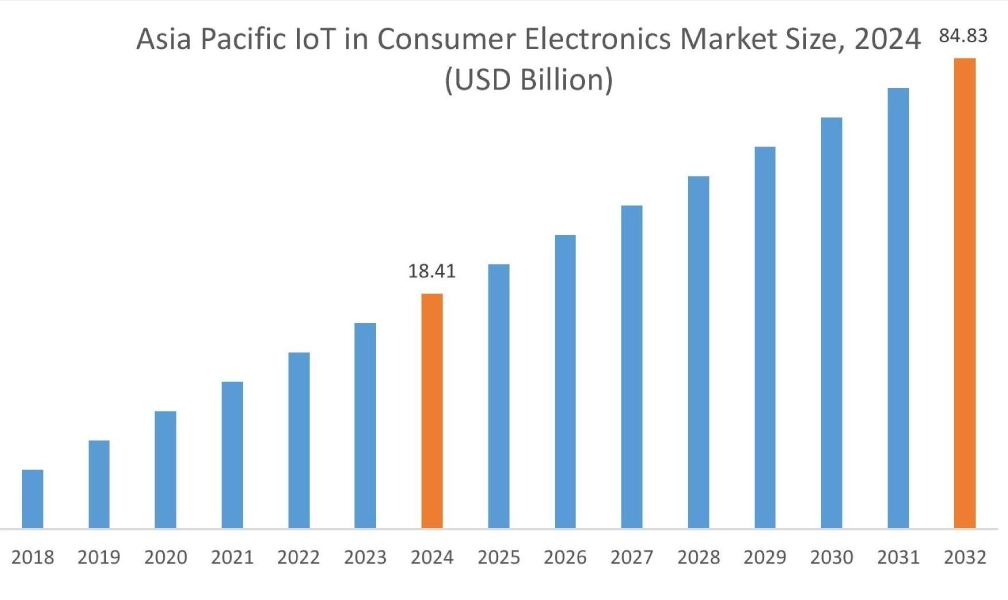
Asia Pacific region was valued at USD 18.41 Billion in 2024. Moreover, it is projected to grow by USD 21.94 Billion in 2025 and reach over USD 84.83 Billion by 2032. Out of this, China accounted for the maximum revenue share of 34.01%. The market progress is mainly driven by rising government initiatives as well as rapid urbanization. Furthermore, factors including the increasing disposable incomes and significant investments in IoT infrastructure, such as 5G networks, are projected to drive the market progress in the Asia Pacific region during the forecast period.
- For instance, in February 2024, LG Electronics India launched MyView smart monitor, which features a webOS-based IoT hub that connects various smart home appliances at homes and offices for entertainment.
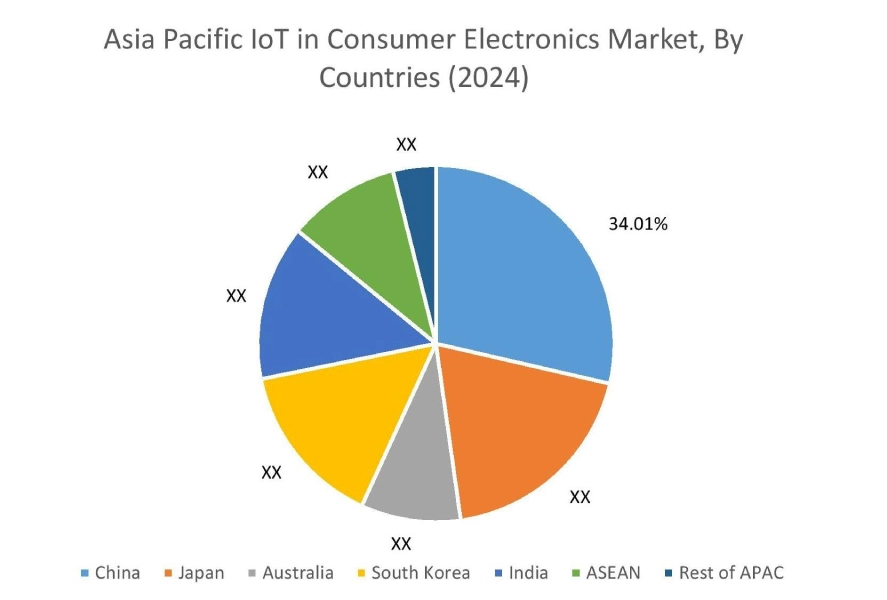
North America is estimated to reach over USD 93.71 Billion by 2032 from a value of USD 20.71 Billion in 2024 and is projected to grow by USD 24.64 Billion in 2025. The North American region's strong consumer need for connected devices like smart homes and wearables offers lucrative growth prospects for the market. Additionally, the progress of digital ecosystems and cloud platforms, as well as increased investments in IoT innovation and smart city projects, is driving the market progress.
- For instance, in September 2023, Lexmark partnered with HARMAN to integrate Lexmark's IoT technology with medical devices and connected products.
The regional analysis depicts that the strong consumer desire for convenience and smart home automation, as well as robust digital infrastructure, is driving the market in Europe. Additionally, the key factor driving the market is the government investment in smart city initiatives and digital transformation, as well as rising consumer need for smart devices is propelling the market adoption in the Middle East and African region. Further, the increasing internet and smartphone penetration and widespread adoption of 5G technology are paving the way for the progress of the market in the Latin America region.
Top Key Players & Market Share Insights:
The global IoT in consumer electronics market is highly competitive with major players providing IoT in consumer electronics to the national and international markets. Key players are adopting several strategies in research and development (R&D), product innovation, and end user launches to hold a strong position in the IoT in consumer electronics industry. Key players in the IoT in consumer electronics market include-
Recent Industry Developments :
Product launches
- In August 2024, Samsung Electronics launched Diamond’s IoT Security Rating Verifications for its Home Appliances product portfolio, as well as integrating AI capabilities into products in a safer environment.
IoT in Consumer Electronics Market Report Insights :
| Report Attributes | Report Details |
| Study Timeline | 2019-2032 |
| Market Size in 2032 | USD 286.77 Billion |
| CAGR (2025-2032) | 15.87% |
| By Product Type |
|
| By Technology |
|
| By Connectivity |
|
| By Sales channel |
|
| By Application |
|
| By Region |
|
| Key Players |
|
| North America | U.S. Canada Mexico |
| Europe | U.K. Germany France Spain Italy Russia Benelux Rest of Europe |
| APAC | China South Korea Japan India Australia ASEAN Rest of Asia-Pacific |
| Middle East and Africa | GCC Turkey South Africa Rest of MEA |
| LATAM | Brazil Argentina Chile Rest of LATAM |
| Report Coverage |
|
Key Questions Answered in the Report
How big is the IoT in the consumer electronics market? +
The IoT in consumer electronics market size is estimated to reach over USD 286.77 Billion by 2032 from a value of USD 64.07 Billion in 2024 and is projected to grow by USD 76.16 Billion in 2025, growing at a CAGR of 15.87% from 2025 to 2032.
Which segmentation details are covered in the IoT in consumer electronics report? +
The IoT in consumer electronics report includes specific segmentation details for product type, technology, connectivity, sales channel, application, and regions.
Which is the fastest segment anticipated to impact the market growth? +
In the IoT in consumer electronics market, the smartphone are the fastest-growing segment during the forecast period due to widespread availability of high-speed internet as well as growing demand for convenience, automation, and enhanced lifestyles.
Who are the major players in the IoT in consumer electronics market? +
The key participants in the IoT in consumer electronics market are Samsung (South Korea), LG (South Korea), Intel (U.S.), IBM (U.S.), Sony (Japan), Toshiba (Japan), Schneider Electric (France), Texas Instruments (U.S.), Apple (U.S.), Panasonic (Japan), and others.
What are the key trends in the IoT in consumer electronics market? +
The IoT in consumer electronics market is being shaped by several key trends including IoT integration fosters personalized insights into health and daily life which enables chronic disease management, remote diagnostics, and personalized health feedback as well as IoT systems help companies automate tasks, monitor operations, and manage processes, leading to increased productivity and reduced operating costs are the key trends driving the market.
